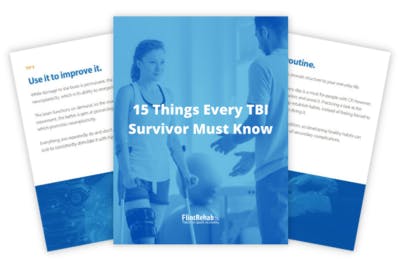No products in the cart.
No products in the cart.
No products in the cart.
No products in the cart.
Home » Neurological Recovery Blog » Traumatic Brain Injury » 5 Effective Eye Exercises for Concussion Patients to Improve Vision
Last updated on October 8, 2019

Concussions can cause a person to experience many vision problems. Fortunately, vision therapy can help relieve many of those symptoms.
Today’s article will show you some of the best eye exercises for concussion that you can do on your own at home.
Vision problems are a possible secondary effect of brain injury, even mild brain injury such as concussion. Vision problems can range from double vision to bouncing images.
The following eye exercises will strengthen your eye muscles and work towards restoring proper vision.
This eye exercise for concussion patients was designed to help your eyes transition from looking at an object close by to looking at something far away.
What you need: Two papers with a letter written on each.
Remember to only use your eyes; do not move your head.
This next exercise will improve your tracking abilities.
What you need: Something that swings, such as a yo-yo.
If this exercise is too difficult at first, try using only one eye at a time (close the other eye or cover it with your hand or a patch). Once you can do that without difficulty you can transition back to both eyes.

This eye exercise for concussion recovery was designed to help you regain the ability to focus on close objects.
What you need: Fruit Loops or Cheerios and a pipe cleaner (a shoelace can also work, just tie a knot at the end of it so the loops don’t slip off).
For an extra challenge, you can add a cognitive element to this exercise. Have someone say a word that you must find the opposite word to (e.g. day/night; black/white; tall/short, etc.) while keeping your eyes focused on the loop at all times.
Saccades refer to the fast and jumpy eye movements required to move eyes from one fixation point to another quickly and accurately. This vision exercise was designed to improve the precision and speed of saccadic eye movements after a concussion. These precise movements are necessary for reading and focusing.
What you need: Two sticky notes and a Sharpie

These eye exercises will help improve your near-sighted vision and your ability to focus on a moving object.
What you need: One pencil.
Try to practice this exercise for ten minutes or however long you can handle.
If you want to see fast improvements from these vision exercises, you will need to use a technique therapists call massed practice. That’s a technical term that means doing a lot of exercises several times a day.
That’s because massed practice is one of the best ways to activate the brain’s natural healing mechanism, neuroplasticity.
But you must be consistent, which will take a high amount of discipline. Don’t just do your exercises every once in a while; try to do them at the same time every day.
The more you practice these eye exercises for concussion, the more neural pathways your brain will create in response. That means the exercise will eventually become easier, and your vision will improve.
We wish you luck with the rest of your concussion recovery.

If you like our content, you’ll love our ebook and newsletters! Get instant access to our TBI recovery tips ebook with 20 pages of helpful advice by signing up below.
You’ll also receive our emails that share survivor stories and more useful TBI recovery tips, which you can opt out of at any time. (We know you’ll love them, too.)
We will never sell your email address, and we never spam. That we promise.


Time with a speech therapist is extremely valuable during recovery, especially if you struggle with communication, critical thinking, or memory after brain injury. Insurance typically covers speech therapy for a fixed amount of time. But once it’s over, recovery is in your hands.
That’s why a team of neuroscientists and clinicians from Boston University created the CT Speech & Cognitive Therapy app. Designed for those recovering from stroke, TBI, or living with neurological conditions, the app contains over 100,000 cognitive exercises that are all available right from your phone or tablet. That’s like having a speech therapist by your side whenever you want!
This app is the perfect fit if you want to improve your speaking, memory, or general mental sharpness. And, it’s affordable at just $29.99/month!
“For the past 6 months, my son has used the app about three times a week. The app is like a virtual therapist, it’s very easy to use, and it gives him immediate feedback.
He now understands things faster, can make decisions with less hesitation, has improved recognition of words, and his confidence is higher. I also find it easy to get in touch with customer service; they pleasantly help out. The whole experience has been great.”
— Miriam
With the CT App, you can get the guidance you need right from your phone or tablet. You can use it on your own or in between sessions with your speech therapist.
Whether you struggle with aphasia, memory loss, or critical thinking, the CT Speech & Cognitive Therapy App can help.
“The CT app has helped me gather my confidence by building on and reinforcing old forgotten skills. It helps to see my percentages increase, and work harder when they decrease. It’s very self-motivating.” -Kathryn
We are confident that this app will help improve your speech and cognitive function after brain injury. Like our recovery tools, the CT App is also covered by our 30-day money-back guarantee.

Do you know these 15 TBI recovery tips?
Get a free copy of our ebook 15 Things Every TBI Survivor Must Know. Click here to get instant access.
Grab a free rehab exercise ebook!
Sign up to receive a free PDF ebook with recovery exercises for stroke, traumatic brain injury, or spinal cord injury below: